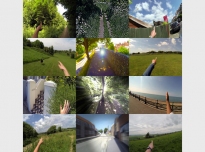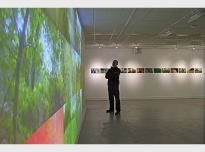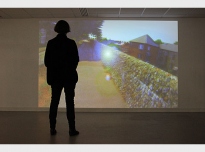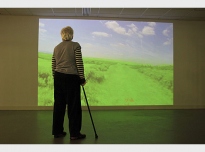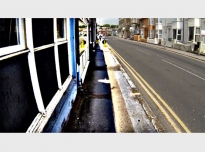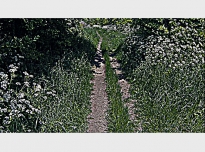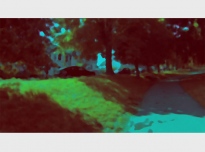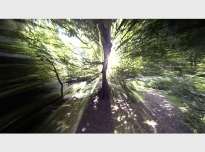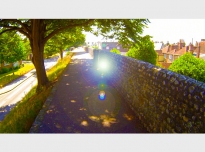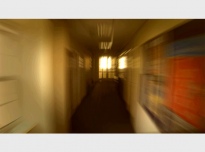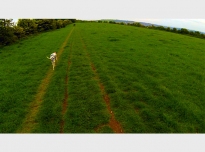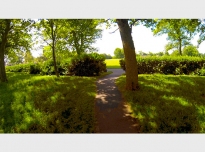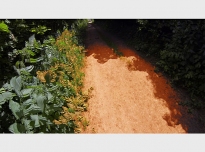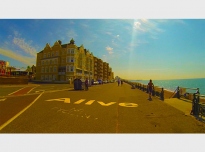Significant Walks, 2015
“Walking is usually about something else – about the walkers character or encounters, about nature or about achievement, sometimes so much so it ceases to be about walking.” 1
Significant Walks is a Wellcome Trust funded research project exploring the reality of walking for individuals with chronic lower back pain. Led by Shirley Chubb the collaborative research team (see details below), worked with a group of participants from East Sussex to present an immersive digital artwork synthesizing eye level video documentation of participant’s personal walks with simultaneously gathered biomechanical data. The team worked with participants to identify the most effective way to express the nature and challenge of their personal movement by exploring the interpretive qualities of visual effects processes. Initially presented as an immersive video, the life size scale of the work engages viewers in micro journeys that both interpret clinically accurate data and express individual experience.
The project builds upon the research team’s mutual interests in the resonance of walking as an interpretive tool with the group coming together in response to Shirley Chubb’s site specific exhibition Thinking Path.
Through discussion the research team came to realise the potential of Chubb’s experiential approach as a means to conceptualise physical problems. Working with participants from the large but predominantly unrecognized community of people with chronic lower back pain the team and participants have explored the experience of walking with this condition. Lightweight high definition video cameras were used to record eye level views of participant’s walks, whilst state of the art inertial sensors simultaneously monitored posture and movement. This material forms the basis of the projected artwork that synthesises video footage with it’s corresponding stream of kinematic data. By exploring the use of digital technologies the work develops a sense of ‘presence’ in the world and has attracted interest from a variety of audiences including those interested in the visual arts as well as patient groups, health professionals and students and interested parties from a range of discipline areas.
Collaborative Research Team
The project team benefits from the inclusion of four discipline areas, sharing expertise in the visual arts, musculoskeletal physiotherapy and biomedical engineering. An essential element of the project is the additional interpretive involvement of participants, with each stage of project development reliant on mutual input to develop and realise the resulting outputs.
The project explores the emerging use of inertial sensors in biomedical sciences and the expertise of the project team enables participants to explore an innovative approach to expressing their individual engagement with the world.
The relationship between the individual and their sense of place is seminal to Chubb’s practice, which explores how our experiential engagement with cultural and social environments shapes our understanding of the world. Significant Walksfurthers her interest in synchronic approaches to production, and builds on her methodology of manifesting factual measurements of time, space or site as interpretive expressions of an individual’s engagement with the world. 2 Here the synthesis of video documentation and kinematic data generates tangible visual representations of the link between external and internal movement, with the significance of each individual’s walk crucial to this process.
The resonance of walking as a metaphor for understanding our individual place in the world is key to this research, both for participants and viewers. Walking is a part of our daily existence, providing opportunities to consider how we interact, navigate and respond to our environment. Given the prevalence of chronic low back pain this experience is compromised for many people and Significant Walks seeks to capture these individual realities by animating quantitative data whilst simultaneously communicating qualitative experience. The resulting immersive artwork acts as a vehicle for both the science of data collection and also the reality of the individual at the core of scientific understanding, reminding us that in considering the experience of others we can better appreciate our own realities.
Research team:
Dr Shirley Chubb
Reader in Interdisciplinary Art
University of Chichester
Professor Ann Moore
Professor of Physiotherapy and Head of the Centre for Health Research, University of Brighton
Dr Kambiz Saber-Sheikh
Coordinator of the Human Movement Laboratory
University of Brighton
Neil Bryant
Artist & Digital Media Specialist
University of Chichester
1 Solnit, R. Wanderlust, London: Verso (2002) p.132
2 Chubb, S. (2011) “Location & Intervention: Visual practice enabling a synchronic view if artefacts and sites.” in Dudley, S. Ed. The Thing About Museums: Objects and experience, representation and contestation. London: Routledge. p.199-213
![]()




